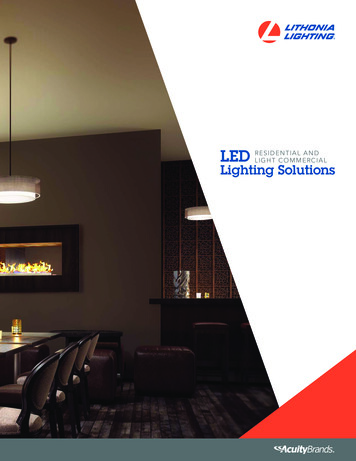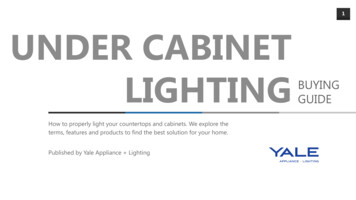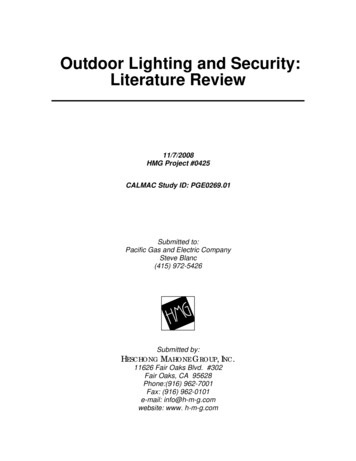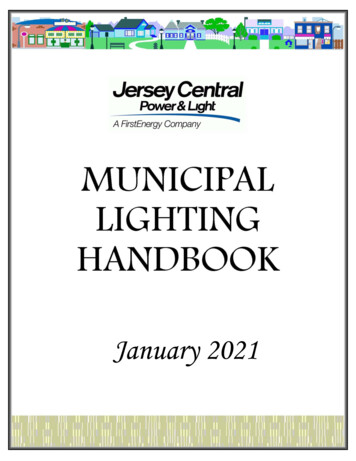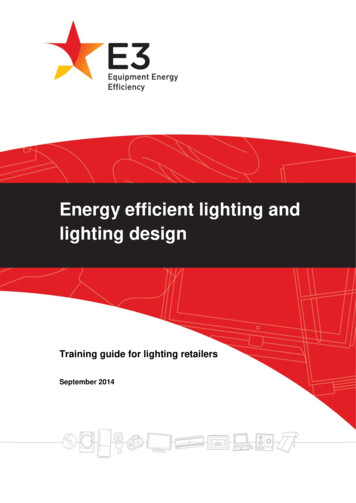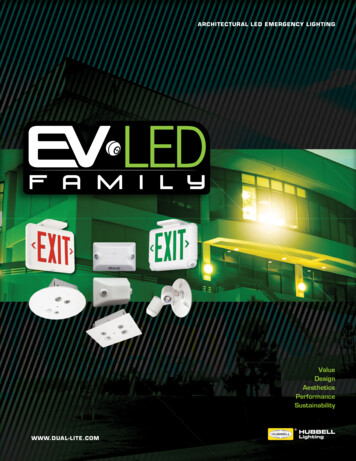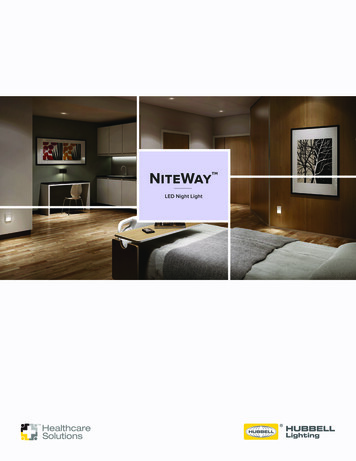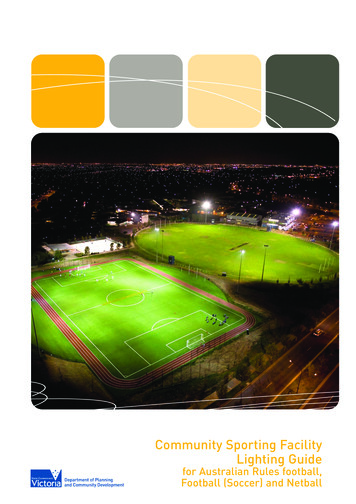
Transcription
Community Sporting FacilityLighting Guidefor Australian Rules football,Football (Soccer) and Netball
IndexMinister’s Foreword . . . . . . . . . . . . . . . .3Introduction . . . . . . . . . . . . . . . . . . . . . .4Glossary . . . . . . . . . . . . . . . . . . . . . . . .5The Planning ProcessPlanning Permits . . . . . . . . . . . . . . . . . .6Spill Light . . . . . . . . . . . . . . . . . . . . . . . .6Building Permits . . . . . . . . . . . . . . . . . . .6Budget . . . . . . . . . . . . . . . . . . . . . . . . . .7Equipment . . . . . . . . . . . . . . . . . . . . . . .8Planning Power and Electrical Supply .9Control Supply –How should lights be controlled? . . . . .10Operation and MaintenanceOperation and Maintenance Manuals . .11Usage Patterns . . . . . . . . . . . . . . . . . . .11Sports Light Aiming and Commissioning12Light Loss Factor (previously knownas Maintenance Factor) . . . . . . . . . . . .12Environmentally Sustainable DesignsSports Light Quality . . . . . . . . . . . . . . .13Control Gear Wattage . . . . . . . . . . . . . .13Duration – Hours of Use . . . . . . . . . . . .13Australian Rules Football LightingKey Standards . . . . . . . . . . . . . . . . . . .14Illuminance Requirements . . . . . . . . . . .14Types of Floodlights . . . . . . . . . . . . . . .16Height and Type of Poles . . . . . . . . . . .17Layout and Pole Locations . . . . . . . . . .18Football Lighting Plan Example . . . . . . .19Budget . . . . . . . . . . . . . . . . . . . . . . . . .22Pole Supply Costings (Typical) . . . . . . .232Football (Soccer) LightingKey Standards . . . . . . . . . . . . . . . . . . .24Illuminance Requirements . . . . . . . . . . .25Types of Floodlights . . . . . . . . . . . . . . .26Pole Height . . . . . . . . . . . . . . . . . . . . . .28Layout and Pole Locations . . . . . . . . . .28Side Pole Design . . . . . . . . . . . . . . . . .28Corner Pole Design . . . . . . . . . . . . . . .29Multiple Pitches . . . . . . . . . . . . . . . . . .30Offsetting of Pitches . . . . . . . . . . . . . . .31Multi-use Sports Fields . . . . . . . . . . . . .33Football (soccer) Lighting Plan Examples .35Budget . . . . . . . . . . . . . . . . . . . . . . . . .44Pole Supply Costings (Typical) . . . . . . .45Outdoor Netball LightingKey Standards . . . . . . . . . . . . . . . . . . .46Types of Floodlights . . . . . . . . . . . . . . .47Height and Type of Poles . . . . . . . . . . .48Netball Lighting Plan Examples . . . . . . .49Budget . . . . . . . . . . . . . . . . . . . . . . . . .53Pole Supply Costings (Typical) . . . . . . .54Where to Get Further Help . . . . . . . . .55Checklist . . . . . . . . . . . . . . . . . . . . . . .56Examples of Lighting ProjectsAustralian Rules Football . . . . . . . . . . .57Football (Soccer) . . . . . . . . . . . . . . . . .58Netball . . . . . . . . . . . . . . . . . . . . . . . . .59
Minister’s ForewordThat’s why I’m pleased to present theCommunity Sporting Facility LightingGuide.This Guide is designed to answer keyquestions local clubs, organisations andcouncils may have when undertakinglighting projects for Australian Rulesfootball, football (soccer) and netball.It offers recommendations for planning,design, maintenance and operation ofa variety of lighting systems.This Guide will assist local sportingclubs, organisations and councilsdevelop facilities for communities toenjoy well into the future.Local sporting facilities create a placewhere people gather with family andfriends to keep active and socialise.Across Victoria, we are now experiencingincreased demand for our sporting facilitiesdue to large participation numbers inseveral sports including football (soccer),Australian Rules and Netball. In recentyears the demand on playing facilities forthese sports has meant developinginnovative solutions to cater forparticipation needs.The provision of more uniform, higherquality and practical sports lighting ishelping meet this demand. However, asmany of us know the provision of sportslighting can be a complex and technicaltask without the correct information.3HUGH DELAHUNTY MPMinister for Sport and Recreation
IntroductionThe Community Sporting Facility LightingGuide for Australian Rules football, football(soccer) and netball has been developedto assist clubs and councils to installeffective sports lighting for their facilities.Some components in this Guide aretechnical in nature and are thereforepredominantly provided to inform clubsand councils in their discussions withqualified lighting experts.This Guide covers key topics that councilsand clubs will need to consider whenplanning a sports lighting project. Theseinclude: Planning process Planning the power supply Maintenance and operation Environmentally sustainable design Types of lighting Pole height and location Design standards for training andcompetition Where to get further assistanceThis Guide is divided into four sections.Section One covers general information toplan a lighting project which is suitable forall sports lighting projects. The remainingthree sections contain sport specificinformation relating to Australian Rules,football (soccer) and netball.A range of useful tips have been providedthroughout the Guide to highlight anumber of planning considerations forlocal clubs and councils.4
GlossaryThe following table defines key lighting terms.TermMeaningColourRenderingIndex (CRI)Measure of the degree to which the colours of objects illuminated by agiven lamp conform to those of the same objects under an ideal lightsource of similar colour appearance. CRI range from 0-100. Thehigher the CRI, the better the colour rendition appears. Aninappropriate colour rendition can deceive the eye and supply it withwrong information.FloodlightA lamp designed specifically for floodlighting or sports lighting (usuallyweatherproof).Glare ratingA numerical value on a scale of 0 to 100, determined in a specifiedmanner, representing the degree of glare from a lighting system forgiven observer positions and viewing directions. Higher valuescorrespond to greater glare from the lighting system.Illuminance(Lux)The total amount of visible light illuminating a point on a surface fromall directions above the surface. The standard unit for illuminance isLux (lx). For a lamp it normally refers to the total light emittedirrespective of the directions in which it is distributed.Kilowatt (kW)The total power requirements for a series of lamps – a lightingsystem – are usually defined in terms of kilowatts. One kilowatt equals1000 watts.Light loss factorThe ratio of the illuminance provided by an installation in the averagecondition of dirtiness and with a lamp of average age expected inservice, to the initial illuminance provided by the same installation.Metal halidelampA high intensity discharge lamp with high efficiency and good colourrendition. These lamps are used in stadiums, warehouses andindustrial settings.Principal Playing All portions of all surfaces which the ball or participants may touchAreaand be considered in play in accordance with the rules.Uniformity ratios Describes the uniformity of light levels across an area. This may beexpressed as a ratio of minimum to average or it may be expressedas a ratio of maximum to minimum level of illumination for a givenarea.Watt (W)The watt is a unit for measuring electrical power. It defines the rate ofenergy consumption by an electric device. The power input to a lampis usually measured in watts.Source: Standards Australia,Sports Lighting Part 1: General Principles,Volume 2560.1 - 20075
The Planning ProcessThis section assumes the appropriatepre-planning has been undertaken toascertain that a sports lighting projectis needed.New or amended sports lightinginstallations will need to considerobtaining statutory planning consentand other appropriate approvals.Planning PermitsA planning permit is a statement that aparticular use or development (subdivision,buildings, and works) may proceed ona specified parcel of land. Sometimes apermit is specific to a nominated personor operator. It is always subject to a timelimit and will expire under specifiedcircumstances. The responsible authority(usually local council) is entitled to imposeconditions when granting a permit.If you propose to use or develop land,first discuss the proposal in detail withyour local council planning and recreationdepartments. Early discussion will confirmwhether a planning permit is necessaryand highlight likely conditions. Typically,sports lighting upgrades do not requirea permit.The planning permit process may requireconsultation with surrounding residentsand other stakeholders. Organisationsshould consider undertaking communityconsultation prior to seeking a planningpermit to help address any communityconcerns.It is important not to confuse planningpermits with building permits. Buildingpermits relate to the method of constructionof a building or development to ensureit complies with relevant standards.A planning permit does not removethe need to obtain a building permit.When applying for a planning permit,applicants should use their local council’sPlanning Permit Application form andinclude the prescribed permit applicationfee (refer to the Planning and Environment(Fees) Regulations 2000), and all necessarysupporting information, such as accurateplans, reports and photographs.6Spill LightAs residential properties are often in closeproximity to sporting fields, spill light issues(i.e. light that falls outside the areaintended to be lit) need to be consideredin the planning process. Planning permitsoften require verification of obtrusivelighting provisions (i.e. calculation of spilllight to nearby residences). There may alsobe special traffic and aviation spill lightingrequirements that apply to your area.Building PermitsMany light pole installations will require abuilding permit, irrespective of whether aplanning permit is also required. In manyinstances local council is the landownerand needs to grant permission for anyworks to be carried out on its land. TheBuilding Regulations 2006 indicate thatfor poles not attached to a building, apermit is required when they are overeight metres in height. Further informationabout the building permit process can beobtained from the building department ofyour local council.
The Planning ProcessTips & Suggestions If planning permits require verification of Obtrusive Lighting Provisions(i.e. calculation of spill light to nearby residences or other sensitive locations),include this into your project design brief and be aware that additional designtime may be required. Establish the proximity and orientation of any nearby residential areas at thetime of planning the site design layout. Simple matters like field/court orientationand set out can help limit spill light to residential areas. Typically greater than20m distance from a property boundary will likely see less light spill. Identify any particularly sensitive locations that may be impacted by proposedsports lighting e.g. main roads and/or intersections. Consider proximity to airports and ensure civil aviation requirements forscreening of sports lights are addressed. Restrictions typically exist up to 6kmsaway from airport runways.BudgetThe budget tables included in this guideprovide a breakdown of indicative costs fora new sports lighting installation consistentwith the sample layouts highlighted. This iscurrent at the time of writing (2011) andannual cost escalations should be takeninto account.There are a number of factors that willhave a bearing on probable costs toestablish new or upgraded sports lighting.It is recommended that the budget beused as a guide only as site specificfactors and implementation aspects willvary between projects (e.g. power supplyrequirements).Existing installations give rise to differentcost considerations. Questions regardingsuitability of the existing equipment to beused as part of an upgraded design needto be carefully considered to ensure theycomply with the current AustralianStandards (AS). Be particularly mindfulof the pole height as many older polesdo not meet current Australian Standards.7For new sports lighting, soil conditionsshould be considered as this may impacton the placement of poles and overallcosts. For example many recreationalreserves are constructed over landfill siteswith poor soil conditions. Alternatively,facilities may be constructed on siteswhere rock is commonly encountered.Therefore, it is critical to obtain ageotechnical report of soil conditions atthe proposed pole locations in conjunctionwith a structural engineer advising on thepole foundation designs. A geotechnicalreport typically costs 2,000 and shouldbe included in your budget.
The Planning ProcessEquipmentSports lighting should be designed andinstalled so that the sport being conductedcan be comfortably performed by theparticipants and officials and viewed byspectators.Before installation, considerationshould be given to determine whatthe intended purpose of play is; training,club-competition or semi-professional play.Making provision for upgrades (e.g. polesize and cabling) can significantly reducethe cost of upgrades in the future.The decision to install sports lightingshould be made following consultationbetween the user groups, council andpeak sporting bodies. Visiting sites withdifferent levels of lighting also providesproject proponents with a practicalunderstanding of what variouslux levels actually mean.Project InsightIn 1991 the Learmonth Footballand Netball Club upgraded theirAustralian Rules football lightingto an average of 100 lux withinfrastructure in place toaccommodate additional lightingupgrades into the future. In 2008the Club was able to upgrade theirlighting to over 150 lux whilst stillmaintaining Australian Standardswithout the need to replace polesor upgrade power supply.(See page 57 for more details.)8The sports lighting installations can alsoserve to intentionally illuminate the areaswhere spectators gather. Poles can beused to mount other lights to illuminateperimeter areas. This needs to beconsidered when specifying poles andallowing the provision to mount suchlighting (usually at lower levels on thepoles), using separate electrical cablinginfrastructure. This will allow operationof the lights for different times andrequirements, such as public lighting.
Planning Power and Electrical SupplyContact your local electricity companyearly in the process to organise power tothe facility. Consider who is paying forthe power use. Options include providinga separate metered account, installing acheck meter which logs hours of use orpayments based on typical usagepatterns.Power supply requirements should bediscussed early in the planning processto ensure supply requirements can be metfor both immediate and future lux levels.A field of play will vary in its powerdemand requirements depending on theillumination level. Competition level lightingpower demands are often greater than therest of the facility’s demand combined.In addition, many sports lights have ahigher demand during start up and thisdemand needs to be carefully consideredwhen selecting the electrical supply andcable reticulation.Power supply to each pole can come fromeither the clubroom main switchboard (fortraining level) or a dedicated floodlightingswitchboard and submain supply systemfor each pole (for competitive level). Ensureexisting switchboards have the capacity tocope with additional requirements.9Health and Safety tipThe power supply to each polecan come from the clubroom mainswitchboard. While not mandatory,control via a suitable ResidualCurrent Device is recommended.The Residual Current Device isdesigned to disconnect the powersupply to prevent an ‘electricalleak’ which can cause fatal injurythrough an ‘electric shock’.Tips & Suggestions Establish what method will beused to meter/record lightinguse, particularly for the purposesof attributing power bill paymentsand maintenance. Determine the power supplyrequired to meet immediate andfuture levels of play. Ascertainwhether the supply required isreadily available and any potentialcosts.
Planning Power and Electrical SupplyControl Supply – How shouldlights be controlled?Training level lighting is often controlleddirectly through manual switches.Club competition level lighting canalso be controlled in a similar way ona pole-by-pole basis. Pole switches canbe located at a central location or at thebase of each pole.Switches should be either operated bykey, in a lockable enclosure or locked ina controlled area accessible to authorizedpersons only. Accessibility should beconsidered when locating lighting controls.A useful and inexpensive additionalmeasure is to fit an hours-run indicator tolog operating hours. This allows clubs tokeep track of energy use ( hours x totalrated wattage of lights) and provides a logfor repair and maintenance purposes.Environmental tipThe configuration of competitionlighting in set groups (banks)enables the provision of lowerlighting levels to suit training use.This will save energy, reducerunning costs and increase the lifecycle of the lamps.Project InsightLighting at the Fawkner SecondaryCollege Synthetic Pitch is controlledthrough a key lockable switch torestrict the operation of floodlights toauthorised persons.(See page 58 for more details.)10Diagram 1 – The pole is permanentlywired from the club switchboard. A keyswitch at the base of the pole provideslighting control of a playing surface.
Operation and MaintenanceSports lights are usually operatedmanually. Curfew timers can, however,offer a simple inexpensive energy savingmeasure to ensure sports lights do notburn excessively if they are accidentallyleft on. Curfew timers can also ensurethat sports lights are not run past a set‘curfew’ time that have been set inagreement with local residents orcouncil policy. N.B. Curfew timers arenot appropriate if the lighting could beused by emergency services.Operation and MaintenanceManualsOperation and maintenance manualsprovide guidance on the correctoperation and maintenance of floodlights.Developing an operation and maintenancemanual at the time of the sports lightinginstallation will assist with the longevityand performance of lights.Section 4 in AS 2560.1-2002 containsuseful details concerning ‘Maintenance ofOutdoor Lighting Equipment’ which shouldbe used when developing a maintenancemanual.The operation and maintenancemanual should identify a policy for lampreplacement and should specify howregularly lights are cleaned. Manufacturer’sadvice should be sought regardingcleaning procedures and any othermaintenance recommendations.Labelling each light with a uniquereference and cross referencing this in theoperation and maintenance manual assistswith future maintenance and recordkeeping. Information from hours-runindicators and curfew timers (devices thatautomatically record the hours of lightingusage) should be recorded in theoperation and maintenance manual toassist with further maintenancescheduling.11Usage PatternsLamp manufacturers determine theaverage life of lamps according toexpected usage patterns. Therefore, morefrequent ‘switching on’ of the lights willshorten their life and reduce performance.Manufacturers typically base the averagelife of lamps on a three hour ‘on’operation. Discuss potential implicationswith manufacturers if your lighting’s usagepatterns are expected to differ from this.Be aware that some manufacturers baseaverage life of lamps on a ten hour ‘on’operation which is not consistent withpractical use in a club setting.There are number of factors that affectthe life of a lamp. These include: Lamp lumen depreciation (light outputdrops off with age). Lamp dirt depreciation (light outputwill reduce as dirt accumulates onthe lamps).Aiming has a major impact onperformance. A common factor in poorlight performance is lamps which are notaimed correctly at installation.
Operation and MaintenanceSports Light Aiming andCommissioningIt is important that sports light aiming iscompleted by a professional under thesupervision of the lighting designer orfloodlight supplier. The aiming should beundertaken using specifically designedequipment and not ‘by eye’. The setaiming positions should be recorded incase it is necessary to re-aim errant lightsin the future.Make provision for a commissioning lightingmeasurement test, preferably by anindependent party, to verify that the aiminghas indeed achieved the design outcome.Generally, this involves taking lightingmeasurements on a 10m grid of points andshould be directly compared with the lightingdesign. It is important to allow reasonabletolerances which the lighting designusually states (10% is commonly used).The test should also form a necessarycomponent of proof that the contractorhas delivered the project properly andevidence of this may be required byfunding partners. It is worth noting thatthe test may also be a requirement of thecompetition/league administrator if nightmatches intend to be held.Light Loss Factor (previouslyknown as MaintenanceFactor)To compensate for the progressivedeterioration of a lighting system as itages, an overall compensating factorreferred to as ‘Light Loss Factor’ must beincluded in the design. For averageoutdoor conditions, a light loss factor of0.8 to 0.7 should be included in thedesign calculation. If air pollution is heavy(e.g. in a heavy industrial area) or regularmaintenance is not planned, factors of0.65 or even 0.55 should be used tooffset the increased light loss.Tips & Suggestions Have the contractor developan operation and maintenancemanual at the time ofcommissioning the new orupgraded sports lighting. Themanual should include lampreplacement and cleaningintervals to assist sports lightperformance being maintainedthroughout their life. Aiming is a relatively smallcomponent of many installationsbut has a major impact onperformance. Have it doneprofessionally. Record the final aiming positionof floodlights in the operation andmaintenance manual along withany on site adjustments madeduring commissioning. Install hours-run indicators toautomatically record hours of useto assist with maintenancescheduling. Consider including curfew timersas an energy saving device or tocomply with planning restrictions.12
Environmentally Sustainable DesignSeveral facets of design requireconsideration to optimise environmentalsustainability.Sports Light QuantityMore floodlights equals more power.Designs which minimise sports lightquantity will therefore also help minimisepower use. Lighting installations shouldseek to use the most efficient floodlightspossible with the highest practical lightloss factor (e.g. 0.8).Duration – Hours of UseEnergy is power (watts) multiplied by time.Measures to limit the time lights are in use(e.g. curfew timers or key switch controlspermitting access to authorised personsonly) are relatively inexpensive to install.Costs are typically 300-500 to supply orretrofit. Such measures return the expensequite quickly (typically 3-5 years).Tips & SuggestionsControl Gear WattageControl gear is required to operate sportslights which itself consumes energy. Theamount of energy depends on the makeand model of lamp but typically 50-150Wis consumed on top of the lamp power.Therefore a 2000W lamp may actuallyconsume 2000 150 2150 Watts orclose to 10% more power.Control gear systems are available tooptimise the energy consumption of lampsthroughout their life. This reduces energyconsumption and lowers maintenancecosts as lamps need less frequentreplacement. Sometimes called ‘lumenmaintenance’ strategies, the control gearsystems operate the lamps to obtain amore consistent light output, rather thanhaving high light output at the beginningand diminished output as lamps age.13 Consider energy andmaintenance costs over the life ofthe installation (not just the initialcapital outlay) and budgetaccordingly. Have an appropriately qualifiedprofessional review lightingquotes prior to acceptance toprovide advice on efficiency andperformance.
Australian Rules Football LightingKey StandardsIlluminance RequirementsAS 2560.1 – 2002 Sports lighting Part 1:General PrinciplesThe information outlined in this sectionregarding illuminance is technical in nature.The information is provided to make thereader aware of the standards and to bepassed on to qualified lighting designers/contractors who will then be able to planyour project.AS 2560.2.3 – 2007 Specific Applications– Lighting for football (all codes)AS 4282 – 1997 Control of the obtrusiveeffects of outdoor lightingA basic requirement for illumination of afootball field is that the ball is adequatelyilluminated at all times while in play.The Australian Standards (series 2560.2.3)contains recommendations andrequirements specific to the lighting ofAustralian Rules football. The standarddeals with training and competition, andtakes into consideration spectator viewingrequirements.The Standard contains informationhighlighting the maintained horizontalilluminance (lux) required for training andclub competition at a recreational,amateur, semi-professional andprofessional level for Australian Rulesfootball.The table on page 15 uses informationfrom the Australian Standards andrequirements from the AFL to articulatethe minimum average lux required forvarious levels of play.14Uniformity ratios are an important part ofa complete set of lighting criteria and canhave a positive effect on the quality oflighting installations. An adequate level ofuniformity is required to create balancedlighting conditions so that people’s eyesdo not have to continually adapt to adifferent light level. The MinimumHorizontal Uniformities are given in tworatios, each providing a numericalrepresentation of the uniformity ofilluminance over a given area.This may be expressed as a ratio ofminimum to average (U1) or it may beexpressed as a ratio of minimum tomaximum (U2) level of illumination fora given area. For example, (U1) Clubcompetition and match play minimumuniformity equals 0.5. The lowest levelof illumination should not be less than50% of average (U1) or 30% (U2) ofthe maximum level of illumination.The above values are identified to providefor the safety of the participants and levelof visual tasks anticipated. Factors such aslarge crowds (e.g. more than 10,000) withconsequent longer viewing distances,might require higher values to be chosenthan indicated above.
Australian Rules Football LightingLevel of playTypical ActivityMaintainedaveragehorizontalilluminance (lux)Minimum Maximumhorizontalglareuniformitiesrating(U1) (U2)Recreational levelTouch and tagTouch and tag football.500.3N/AN/AMay be suitable fortraining a local clublevel. 500.3N/AN/A1000.50.350Amateur levelBall and physicaltrainingClub competitionMinimum requirementand match practice suitable for competitionat local club level.Provides minimal viewingdistances for spectators.*(NB: below)Semi-professionallevelMatch practiceSuitable for training at asemi-professional Minimum suitable forcompetition at a semiprofessional l levelMatch practiceProfessionalcompetitionMinimum suitable forprofessional (AFL) match.Source: Lighting Criteria (source Standards Australia, Sports lighting Part 2.3:Specific applications – Lighting for football (all codes)) According to AS2560.2.3 footnote e), Ball and Physical Training is considered to differfrom match practice in that ball and physical training is more controlled, involves fewerparticipants (typically two to four) and the paths of the participants and that of any ballused are more predictable than in a match-practice environment.*NB: If a club, league or council is looking to develop a club night football venue,a minimum of 150 lux should be considered if it wishes to take contemporary viewingexpectations of spectators into account. Where possible, it is recommended thatclubs/councils inspect sites detailed in the guide and other recent installations toincrease their understanding of the impact of different lighting levels.Recent installations include: Woori Yallock Reserve East Point, Ballarat West Oval, North Geelong Carisbrook Recreation Reserve15
Australian Rules Football LightingTypes of FloodlightsThe 2kW Metal Halide Luminaire is astandard floodlight for football sports lighting.It provides a versatile, robust design solutionwith good colour rendering properties andaveragelamp life of 3-5,000 hours.Lighting constructed with an InternationalProtection rating of ‘IP6x’ classificationleads to improved maintenance benefitsand helps reduce costs.The beam characteristics of floodlightsto illuminate a particular playing field willdepend on the size of the playing field andthe number and location of lighting polesavailable.Major lighting suppliers have standarddesigns for various levels of play whichcan prove quite helpful. Caution shouldbe exercised before adopting an indicativelayout as site specific issues such as spilllight and glare-to-light sensitive locationsare not usually considered with suchdesigns.For competition play it may be necessaryto use a combination of the full range ofbeam types described in AustralianStandards (series 2560.1), in order toachieve the required illuminance anduniformity over the playing area. Fortraining, floodlighting types A, B or C (seepictures below) will generally be suitableto achieve the required illuminance anduniformity.Type A floodlightgiving a symmetricalbeamType B floodlightgiving a fan-shapedbeamType C floodlightgiving a fan-shapedbeam withasymmetricdistribution in thevertical planeThe pictured floodlights are commonlyused in four-pole arrangements for lightingplaying surfaces.In the design of Australian Rules footballground lighting installations, carefulconsideration should be given to visualrequirements relating to the comfort of theparticipants and s
Community Sporting Facility Lighting Guide. This Guide is designed to answer key questions local clubs, organisations and councils may have when undertaking lighting projects for Australian Rules football, football (soccer) and netball. It offers recommendations for planning, design, maintenance and ope



